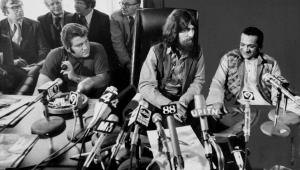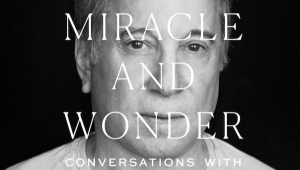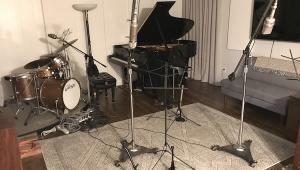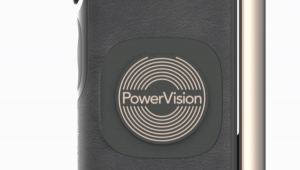The Golden Age of Warner Brothers Records-Part 1
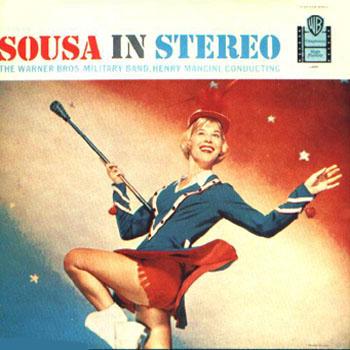
(This piece, originally written in 1988, runs with a few updates)
Maddy Matlock and the Paducah Patrol, Warren Barker, The Vestry Choir, Raoul Meynard and Orchestra, Clint Walker and the Sunflower Serenaders, Gus Farney at the Giant Wurlitzer- these are just a few of the exciting musical acts that helped Warner Brothers Records lose a whopping $3 million a year between 1958 and 1962- its first four years in existence.
Not a great start. In fact the parent company, Warner Brothers films almost shut the doors, but didn’t, according to Fredrick Dannen in his excellent and often hilarious book “Hit Men,” out of fear that it wouldn’t collect money owed by slow paying independent record distributors.
A mere seven years later, Warner/ Reprise was the hottest and hippest label in the record industry, with acts like Jimi Hendrix, The Kinks, Joni Mitchell, Van Dyke Parks, Randy Newman, the Association, The Grateful Dead, Jethro Tull, James Taylor, Van Morrison, Neil Young, The Beau Brummels, The Mothers Of Invention (by way of a subsidiary deal with Frank Zappa’s Bizarre label), Black Sabbath, and Ry Cooder, among others.
What had happened? Strange things: Warners signed an obscure folk trio, Peter Paul and Mary, and began selling lots of records. 
They also got hot with comedians, of all people: Bob Newhart, Don Rickles, a chubby singing comic named Alan Sherman, and a not so chubby one named Bill Cosby. Things were looking up.
Then in 1963 Frank Sinatra, as part of a movie deal, sold his almost broke Reprise label to Warner Brothers films. Frank’s accountant, Mo Ostin- an unlikely choice, stayed on as general manager of Reprise. Things were looking down. But under his guidance, the label got hot with “Rat Pack” artists: Nancy Sinatra, Trini Lopez and Dean Martin, as well as big sellers like Petula Clark.
Meanwhile an obscure Boston disc jockey, Joe Smith went from national promo man to Ostin’s opposite at Warner Brothers. Among his first signings: The Grateful Dead. But that was not what set the stage for the hipness to come. The Dead turned out to be Warner/Reprise’s only heavy psychedelic act (not counting Jimi Hendrix, who defies any categorization).
Instead, it was the 1966 purchase of Autumn Records, a small independent label owned by San Francisco disc jockey Tom Donahue that signaled the real turnaround at Warners .The buyout brought to the label The Beau Brummels, the Tikis, and the Mojo Men. The Beau Brummels had scored big for Autumn with “Laugh Laugh” and “Just A Little”, but the other two acts hadn’t done much. Less than a year after the Autumn purchase, The Tikis changed their name to Harper’s Bizarre and scored a big hit with their version of Paul Simon’s “59th St. Bridge Song” (the “feelin’ groovy” tune). Harper’s Bizarre’s drummer and vocalist, Ted Templeman went on to become one of the more successful record producers in the business. As for the Mojo Men, their main contribution to American music and to Warner/Reprise, was Van Dyke Parks.
There were other touches of gold in Warner/Reprise signings. They dabbled in licensing acts from overseas, signing John “Ozzie” Osbourne’s Black Sabbath and the reconstituted (after the departure of Peter Green) British blues band hardly anyone else wanted: Fleetwood Mac. They picked up The Pentangle from Transatlantic, and the Kinks from Pye.
Jimi Hendrix wasn’t exactly a superstar when Warners licensed his albums from the British Track label. But they sure knew what to do with him. Another Track act signed to American Decca records flopped around for years here before reaching the top. It might not have taken until Tommy for The Who to break big stateside had they been signed to Warner/Reprise.
One artist Warner/Reprise got to first (probably by default) was Randy Newman. 
No self respecting rock and roll label would have released Newman’s string drenched first album- and few-self respecting rock and rollers bought it. But that didn’t matter to Ostin and company, because Newman was good, and that was good enough. With the exception of John Hammond’s tenure at Columbia, no record company has been as supportive of art and artists for their own sakes, as Warner/Reprise. An obvious original and promising musical talent, but with little if any commercial potential at the time, Newman was an investment for the label, and to some degree a risk. But look at what an asset to Warner/Reprise Newman is today- even if he still sells relatively few records.
Through the Bizarre and later the Discreet subsidiary deals, and the company’s purchase of Frank Zappa’s Straight Records, Warner/Reprise gave the world The Mothers of Invention, Captain Beefheart, Alice Cooper, The Persuasions, the GTOs and Wild Man Fisher.
The Beach Boys, revitalized by their Warners subsidiary arrangement, released two of their best albums on Brother Records: Sunflower and Surf’s Up. The only disappointing subsidiary was Raccoon Records: Warners reportedly gave Jesse Colin Young a cool million dollars to start the label, but the mellow singer was never able to repeat his RCA success with The Youngbloods . Bearsville was also a Warner subsidiary for many years.
Ostin obviously turned out to be a man with exquisite taste and an uncharacteristic (for an accountant) chance taker, who, while cognizant of the bottom line, wasn’t tethered to it. He also wasn’t one to jump on bandwagons, so looking back at the Warner/Reprise catalogue twenty plus years later there are few, if any embarrassments.
Compare Warner/Reprise’s consistency with other labels that went on expensive regional buying sprees looking for the next “big thing” (ie: MGM’s “Boston Sound” buyout which got them such heavies as The Beacon Street Union and Ultimate Spinach).
While Ostin still heads the company, the business side of Warner/Reprise has been somewhat less stable. In 1966 Warner Brothers films and records was sold to Seven-Arts a smallish film producer and distributor, which in turn sold both a year later to Kinney Corporation, headed by Steve Ross, which ran funeral parlors, car rental agencies and parking lots. Ross and Ostin: accounting and parking lots. And this was the hippest label in the land during the hippie era. It was so hip, it didn’t matter.
A few years later the record and film divisions of Kinney dwarfed everything else, forcing Ross to rename the whole shebang Warner Communications. Joni Mitchell was wrong: you could have both paradise, and a parking lot.
Everything about the label was likeable- even their low key, humorous, creative, and very personal advertising and promotion. The Warner/Reprise Loss Leaders- two record sets filled with album samples, rare collector’s cuts, good-humored copy and great art work cost $2.00. Today, some of these “loss leader” compilations, with titles like The Whole Burbank Catalog (with a picture of the Earth on the cover), Burbank (with artwork filched from the band Chicago), Schlagers (cover in the style of “Ben-Hur” by the same artist), and my favorite, the melancholy inducing, Days Of Wine And Vinyl (shown here)have become valued collectors items.
Interesting, but of what interest is all of this to audio enthusiasts? For one thing, Warner Brothers released the first “talkie”, Al Jolson’s “The Jazz Singer.” The company has had a long running interest in sound. In fact, Warner Brothers records was created at the outset of the stereophonic high fidelity boom of the late fifties, as a “sound” company- judging by the artists roster it certainly wasn’t begun as a label for great artists who weren’t being recorded. Its slogan was “first name in sound”.
Lee Herschberg started recording for Reprise in the mid sixties and has been Director of Engineering at Warner/Reprise since the late sixties. He began as an engineer with Decca/Coral in 1956 until the label was bought by MCA, which consolidated the two with Brunswick, another associated label. The label’s studio was sold off and Herschberg, along with Wally Heider, Eddy Brackett, Bud Morris and other well known veteran engineers who worked there, moved over to United Western. Soon thereafter, Herschberg began engineering Reprise sessions, including most of Frank Sinatra’s albums from 1965 to the present.
Herschberg eventually went on the Reprise payroll, working for Chief Engineer Lowell Frank. “He did a lot of wonderful things- everything was live, big orchestras, and it was all real quality recordings. They tried to bring to the record business what really hadn’t been done before. A lot of spare no expense, quality products,” Herschberg told me when I spoke with him recently to find out about the “Warner/Reprise sound.” When Frank retired, Herschberg took his place.
It's nothing like “Living Stereo” in the sense that the label didn’t promote itself as having a sound based on some engineering technique. Rather, many of the records released during that time shared a certain open, clean, dry sound that was very extended on top. So much so, that many sounded too bright until playback equipment improved.
Records having that sound include early albums by Ry Cooder (engineered by Herschberg), Joni Mitchell (Henry Lewy), Arlo Guthrie (Doug Botnick), Pearls Before Swine (Rick Horton), Little Feat (George Massenburg) and many others, including Frank Zappa and The Mothers Of Invention, whose sound improved greatly after leaving MGM—a label which offered consistently awful sound and poor pressing quality throughout the sixties and seventies.
Yet according to Herschberg there never was a “Warner/Reprise” sound. In fact, early on, there wasn’t even a Warner Brothers recording studio. “But what about ‘Master Control at Warner’s’- a long, sophisticated looking control board pictured on the back jacket of many early Warner releases, like Sousa In Stereo (WS 1209) featuring The Warner Bros. Military Band conducted by Henry Mancini?” I asked incredulously. “I believe that was a console on one of the film sound mixing stages”, he answered, adding “because as such, we did not have recording studios when we started in 1958”. Next he’ll tell me Warners didn’t really have a marching band!

According to Herschberg, many of the early Warners releases were recorded and mastered at Radio Recorders in Hollywood. Peter Paul and Mary’s startling first album- very dry and clean compared to Capitol’s laid back reverberant sound for The Kingston Trio—was recorded in New York.
Herschberg recalls that United Western studios in Los Angeles devoted a studio to Warner Brothers projects, and built a mixdown studio especially for the new label. Warner/Reprise did not have its own mastering and pressing facilities until 1970. All the label’s work between1964 and 1970 was done by Columbia at their Vine Street facility.
The early days were, according to Herschberg, “the fun days of recording- everything was done pretty much live. All the artists were real performers. All of the musicians could read. Between 1956 and 1963 when I worked at Decca/Coral I probably made and mixed over 300 record albums...we really cranked them out. I think the first board we had at Decca/Coral was a Westrex board- six rotary faders, no EQ, no limiters, no anything, so you had to be really careful how you set up your studio...people are trying to come back to that in ways, but it just isn’t done because the studios in general just don’t have the acoustics that they had in those days”
As for the “Warner/Reprise sound”, Herschberg says, “everyone was moving from live studios to overdubbed controlled sound. There was a new kind of music going on in those days, and I just think there was a uniform goal that everybody was working toward—a type of sound—a whole style of making records. Although everything did go through us, and I did have a hand in every master tape that went through before it was mastered to make sure it was done to our satisfaction”.
I asked the 60 year old Chicago native about specific records and he reminisced: Randy Newman’s first LP (Reprise 6286) which features a full orchestra including a large string section, as well as many well known rock musicians was “....done at Western studio one- everything live. That was a wonderful studio, which is now Ocean Way. We used United studio A and B, as well”, he recalls.

As for Van Dyke Parks’ masterpiece Song Cycle (WB 1727, reissued on vinyl by Sundazed) Herschberg says “I did that- it fried my brains so badly, I refused to mix it. We spent so much time on it- that was an eight track project. We filled up eight tracks, then we did an 8:8 transfer and filled up those and then we did more. It was six straight months of filling every tiny hole in the eight track. Bruce Botnick mixed that. I refused. I needed some time off!
Not every thing Herschberg did during those days turned out as planned. One sonic disaster was the “Haeco-CSG” system. Records using that system were so awful sounding, I remember writing Herschberg to complain, back in 1969 when I was in college.
“It sounded awful”, he admits, “I’m just discovering things we used CSG on. Basically it was a system whereby it introduced phase relationship changes. When you combined your stereo, your center pan didn’t “pop” out- it stays in relative position in mono...so that when things were played on the air in mono- which they were in those days- it wouldn’t build up in the middle- but it introduced some terrible phase things”.
“Almost as bad as “Q” sound”, I joked.
“Well a little different, but it was annoying. I still cringe at those things. I run across these albums every now and then. We actually mixed through the CSG to stereo and there are no straight stereo mixes”, Herschberg said.
The Haeco-CSG system was also intended to allow labels to get rid of their dual mono and stereo catalogs, and label the stereo pressings “mono compatible.” Of course, even if the stereo record sounded right on a mono turntable, after a few plays the low compliance stylus would chew through the vertical modulations. Thus the Haeco-CSG processed records sounded lousy in stereo, and mono. A great solution to the dual catalog problem!
Another controversial engineering move at Warners was Ry Cooder’s Bop Til You Drop the first digitally recorded rock and roll record. Like Roy Halee, Herschberg thinks the 3M recorders used for the project are the best sounding digital machines. “Absolutely was, and still is- that is the few that still work! The maintenance was terrible. It was pretty experimental. The had a lot of problems building heads for the machines and keeping them in alignment and there were differences of opinion about what proper alignment was even among 3M techs. And the machines had a propensity fo crinkling tape every now and then.Recording wise they were terrific”.
Unlike Halee, Herschberg is a digital enthusiast who believes “...it reproduces exactly what you put in, whereas analogue has a way of changing things- adding things like compression. It just has a different sound because of the metal heads and things. It has a softening effect, where digital does not. At least the 3M machines we were using. What you put in is what came out.”
According to Herschberg, “Ry Cooder didn’t particularly like the digital aspect of (Bop.....) . He’s not a digital fan- its not warm enough sounding for him. It was super clean and super quiet, but the top end was different from what anybody had heard. Plus it was recorded at a brand new studio we had just built- the others were recorded at Amigo studios. It was unknown on all fronts. The biggest drawback was the mastering- we weren’t able to master it properly- it had a degree of top end on it the cutting heads the lathe didn’t like (I agree with the cutting heads!-MF). It was a learning process for everyone.”
Another problem for Warner Brothers was getting good sound from second generation tapes sent from abroad for licensed products. The Pentangle, John Renbourn, Jimi Hendrix, Kinks albums, and other British based acts, offer, as you would expect, second rate, disappointing sound compared to original British pressings. Herschberg told me he tries to get original master tapes for CD releases of much of this material, but the tapes are often lost, or hard to obtain.
Fortunately that is not the case with domestic product. Almost all of Warner/Reprise’s master and multi-track tapes are stored in Burbank in climate controlled vaults - archived on computer. For a while master tapes were stored at mastering facilities around the country, where they were used to generate new parts as needed, but now that viny records aren’t being made for most back catalogue items, most have been retrieved. All of the original artwork has also been preserved and catalogued.
Today Herschberg oversees most of the reissue work, often of his own original recordings. “I have been fortunate to be able to go back and redo some of the Sinatra stuff I did 25 years ago and make it better, but most I’ve had to leave alone because I can’t make it any better”.
He did go back and remix Peter and Paul and Mary’s first record from the original three tracks, with help from Peter Yarrow. “We were able to clean up a lot of things, and add some nice reverb and do some things with EQ. My philosophy is to make it sound exactly like the original, because that’s what people like”.
Looking back at his time at Warner/Reprise and the company’s change from square to hip, Herschberg said “I was fortunate to be part of all that. Those were great times, we made great records!” They sure did.






